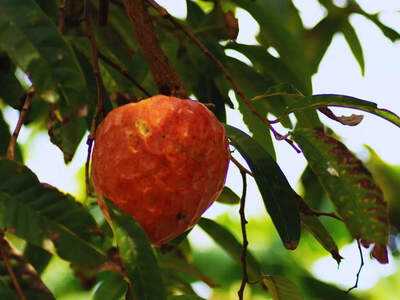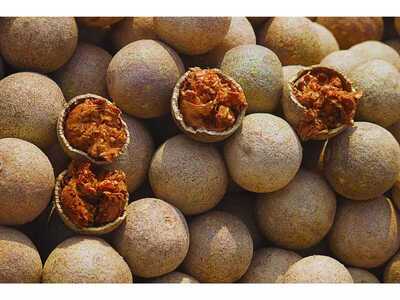When it comes to Indian fruits, bananas, apples and mangoes take away the limelight. But Indian fruit bowls are more than these. There are several fruits in India which are lesser-known, ignored or underutilised for several reasons. Despite being rich in nutrients, they remain largely invisible in mainstream markets.
Let’s have a look at five such ignored fruit gems of India.
Ramphal

Ramphal, also known as bullock’s-heart, is the forgotten custard-apple cousin. This fruit has a creamy texture and flesh. There are fewer seeds than some related species. The fruit is known for buttery flavour and also holds traditional medicinal value. Despite brimming with many qualities, the fruit is rarely commercialised and you rarely see it in the market. But if you get a chance to buy it, try eating it with a little honey and a pinch of roasted fennel. It tastes like kulfi made by nature!
Probable reason behind the ignorance: Maybe because Ramphal has lower shelf life than other fruits.
Karonda

You might have tasted karonda in the form of achar (pickle). This tiny red and white tangy iron-rich berry thrives in arid and semi-arid regions of India. It’s traditionally used in pickles and chutneys. The fruit scores high on nutritional value as it is rich in vitamin C and iron. Yet many urban consumers barely know it.
Probable reason behind the ignorance: Sour taste, small size and limited market appeal makes it a lucrative product
Lasoda/Nisoda

Lasoda or nisoda is basically a sticky desert berry. The fruit has huge nutritional benefits as it is rich in mucilage. It is traditionally used in folk medicine and pickles in parts of Rajasthan and north India. As per reviews on pubmed.ncbi.nlm.nih.gov, the fruit has antioxidant, anti-inflammatory and respiratory-soothing properties. It’s one of the best specialty foods. You can incorporate the fruit in your diet by making lasoda chutney. Tastes divine!
Probable reason behind the ignorance: Unusual texture and unique taste
Phalsa

Phalsa is another lesser-known form of berry. This is a summer berry found in abundance in small towns. People generally use it in making cooling sherbets. Phalsa is rich in antioxidants and traditionally used to counter heat. It also helps in digestion. Although it’s a local’s favourite, it remains out of mainstream retail shelves.
Probable reason behind the ignorance: Hyper-local fruits, extremely seasonal and perishable
Bael/Wood apple

Bael (bel) is another most underrated fruit in India. Despite having digestive and other medicinal properties, the fruit is ignored. Even its strong nutrient and therapeutic values couldn’t help it to bring it to commercial markets. Having said that, bael drink is extremely soothing and filling, especially in summers.
Probable reason behind the ignorance: Unusual flavour; not-an-easy-fruit to peel and pulping is messy
Why these fruits matter (and what travellers/food lovers can do)
Call them lesser-known, forgotten or ignored, these fruits are full of nutritional values and have climate-resilient properties. These delicious fruits of India often grow in marginal soils, and are well-aquantained to local pests and water conditions.
Many of these fruits pack phytonutrients that mainstream fruits don’t. Looking for them in local fruit markets and trying local preparations in the form of pickles, sharbat and chutneys, among others, also support small businesses.
So next time you go to a fruit market, keep your eyes open for these fruits and bring them home and relish something new and flavourful.
Let’s have a look at five such ignored fruit gems of India.
Ramphal
Ramphal, also known as bullock’s-heart, is the forgotten custard-apple cousin. This fruit has a creamy texture and flesh. There are fewer seeds than some related species. The fruit is known for buttery flavour and also holds traditional medicinal value. Despite brimming with many qualities, the fruit is rarely commercialised and you rarely see it in the market. But if you get a chance to buy it, try eating it with a little honey and a pinch of roasted fennel. It tastes like kulfi made by nature!
Probable reason behind the ignorance: Maybe because Ramphal has lower shelf life than other fruits.
Karonda

You might have tasted karonda in the form of achar (pickle). This tiny red and white tangy iron-rich berry thrives in arid and semi-arid regions of India. It’s traditionally used in pickles and chutneys. The fruit scores high on nutritional value as it is rich in vitamin C and iron. Yet many urban consumers barely know it.
Probable reason behind the ignorance: Sour taste, small size and limited market appeal makes it a lucrative product
Lasoda/Nisoda

Lasoda or nisoda is basically a sticky desert berry. The fruit has huge nutritional benefits as it is rich in mucilage. It is traditionally used in folk medicine and pickles in parts of Rajasthan and north India. As per reviews on pubmed.ncbi.nlm.nih.gov, the fruit has antioxidant, anti-inflammatory and respiratory-soothing properties. It’s one of the best specialty foods. You can incorporate the fruit in your diet by making lasoda chutney. Tastes divine!
Probable reason behind the ignorance: Unusual texture and unique taste
Phalsa

Phalsa is another lesser-known form of berry. This is a summer berry found in abundance in small towns. People generally use it in making cooling sherbets. Phalsa is rich in antioxidants and traditionally used to counter heat. It also helps in digestion. Although it’s a local’s favourite, it remains out of mainstream retail shelves.
Probable reason behind the ignorance: Hyper-local fruits, extremely seasonal and perishable
Bael/Wood apple
Bael (bel) is another most underrated fruit in India. Despite having digestive and other medicinal properties, the fruit is ignored. Even its strong nutrient and therapeutic values couldn’t help it to bring it to commercial markets. Having said that, bael drink is extremely soothing and filling, especially in summers.
Probable reason behind the ignorance: Unusual flavour; not-an-easy-fruit to peel and pulping is messy
Why these fruits matter (and what travellers/food lovers can do)
Call them lesser-known, forgotten or ignored, these fruits are full of nutritional values and have climate-resilient properties. These delicious fruits of India often grow in marginal soils, and are well-aquantained to local pests and water conditions.
Many of these fruits pack phytonutrients that mainstream fruits don’t. Looking for them in local fruit markets and trying local preparations in the form of pickles, sharbat and chutneys, among others, also support small businesses.
So next time you go to a fruit market, keep your eyes open for these fruits and bring them home and relish something new and flavourful.
You may also like

UAE: Air Arabia expands Ras Al Khaimah operations with new direct route to Kazan, Russia

Watch: David Beckham becomes Sir David Beckham

Had a 'wonderful interaction' with Syro-Malabar Church leaders: PM Modi (Lead)

Baahubali: The Eternal War Part 1 teaser out, showcases a more intense Amarendra Baahubali

Ministry of Statistics and Programme implementation successfully concludes Special Campaign 5.0






